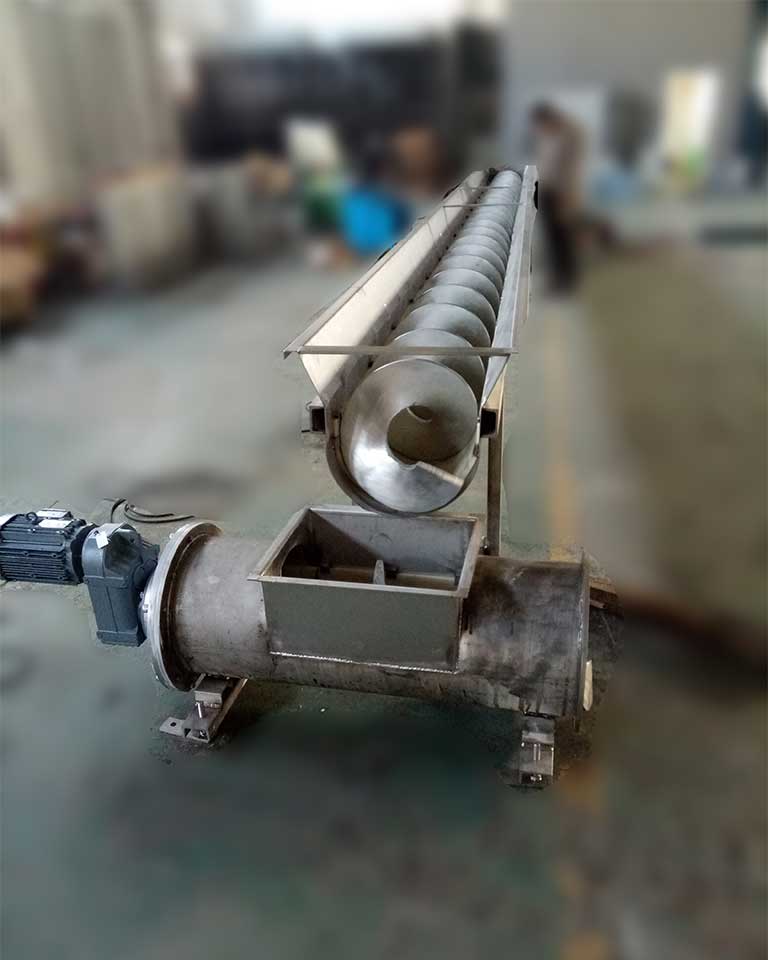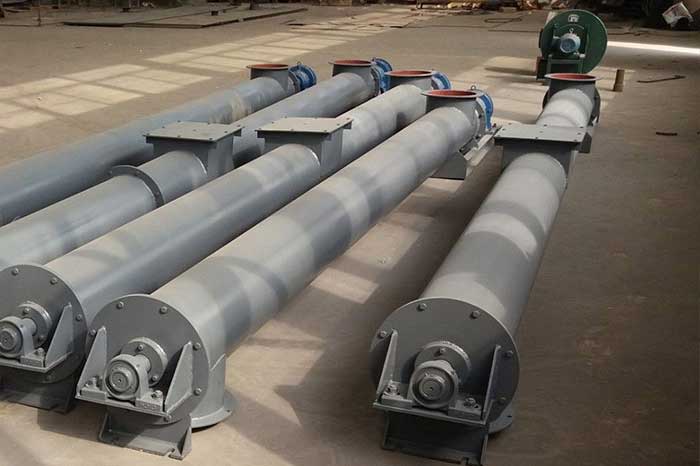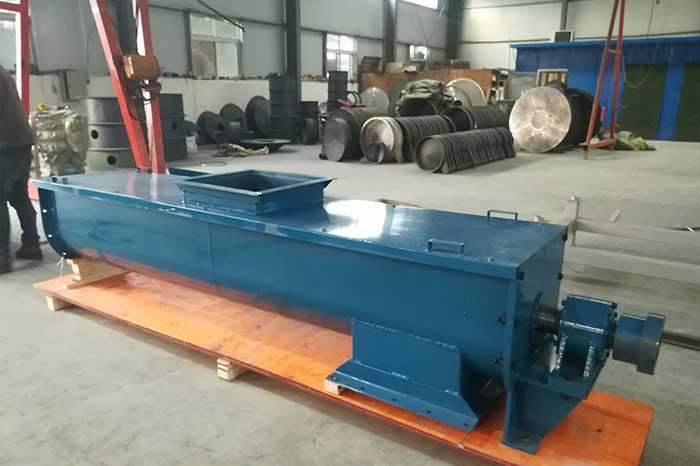Screw Conveyor Manufacturer
Screw Conveyor
UHM is not only an equipment manufacturer but also a solution provider

What is Screw Conveyor
The screw conveyor is a continuous conveying device without flexible traction components, which uses the thrust of the rotating screw to convey the material along the machine trough.
The general structure of the screw conveyor is shown in the figure. It consists of a spiral body composed of a trough, a spiral blade, a rotating shaft, bearings at both ends, a suspension bearing in the middle, and a driving device. The spiral body is supported by bearings at both ends and a suspension bearing in the middle and is driven by a driving device. When the screw conveyor is working, the material enters the chute from the feed port and is driven by the rotating helical blade to move axially along the chute until it is discharged from the discharge port. Read More: screw conveyor wikipedia
| Spiral Dia (mm) | Temp (℃) | INST Angle | Pulverized Coal | Soda | Cement | |||
| Screw Shaft Max RPM (rev/min) | Max. Conv Cap (T/H) | Screw Shaft Max RPM (rev/min) | Max. Conv Cap (T/H) | Screw Shaft Max RPM (rev/min) | Max. Conv Cap (T/H) | |||
| GX150 | ≤200 | ≤20° | 190 | 4.5 | 120 | 3 | 90 | 4.1 |
| GX200 | 150 | 8.5 | 120 | 6.7 | 75 | 7.9 | ||
| GX250 | 150 | 16.5 | 90 | 10.7 | 75 | 15.6 | ||
| GX300 | 120 | 23.3 | 90 | 17.7 | 60 | 21.2 | ||
| GX400 | 120 | 54 | 75 | 35.5 | 60 | 51 | ||
| GX500 | 90 | 79 | 75 | 70 | 60 | 85 | ||
| GX600 | 90 | 139 | 60 | 97 | 45 | 134 | ||

Features of screw conveyor
Pros
Simple structure, low manufacturing cost, easy maintenance, good airtightness of the machine tank, multi-point feeding and multi-point unloading, one conveyor can convey materials in two directions at the same time, and materials can also be transported during the conveying process. The process of mixing, stirring, loosening, heating and cooling, etc.
Cons
During the conveying process, due to the friction between the material and the machine tank and the screw body and the stirring and turning of the material by the screw body, the machine tank and the screw blades are easy to wear, and at the same time have a certain crushing effect on the material, and the transmission power consumption is large. Screw conveyors are sensitive to overload and need to be fed evenly, otherwise they are prone to clogging. When the screw conveyor is arranged obliquely or vertically, its conveying efficiency will be greatly reduced; the conveying length is limited.

Application of screw conveyor
The screw conveyor is suitable for conveying powdery, granular and small-block materials, but not suitable for conveying long-fibrous, hard and bulky materials that are easily bonded into blocks and easily broken. Screw conveyors are mainly used for horizontal transportation that is not too long, or small inclination angle transportation, and in a few cases, they are also used for large inclination angle and vertical transportation. The horizontal conveying length is generally less than 40m, and the longest is not more than 70m. The inclined conveying height generally does not exceed 15m. The vertical conveying height is generally not more than 8m. Some of its deformations are often used as feeding, metering, stirring, drying, kernel shell separation, unloading and continuous pressurization and other equipment.

Two types of screw conveyors
The basic models of screw conveyors include horizontal screw conveyors, vertical screw conveyors and inclined screw conveyors in between. In addition, there are many other types of screw conveyors with both process and special functions. Such as screw feeders, screw unloaders, screw blenders, mobile screw conveyors, bendable screw conveyors, screw conveyors for finished items, etc. Here we mainly introduce the commonly used horizontal screw conveyors and vertical screw conveyors.
Horizontal Screw Conveyor
The horizontal screw conveyor mostly adopts a “U”-shaped trough (cylindrical trough can also be used), a lower screw speed and a fixed installation structure. When the conveyor is working, the material is put into the tank body from one end of the conveyor, and is transported to the other end of the tank body or discharged through the opening at the bottom of the tank body at a certain intermediate position.
Vertical screw conveyor
The vertical screw conveyor can lift general bulk solid materials vertically. There are two feeding methods: self-flow feeding and forced feeding. Shown is a schematic diagram of a forced-feed vertical screw conveyor. The trough of the vertical screw conveyor is a closed cylinder, and the rotation of the screw can be driven by the bottom or the top. The advantages of the vertical screw conveyor are simple structure, small space and low manufacturing cost, but the disadvantage is that the conveying volume is small, and the conveying height generally does not exceed 8m.

Use and maintenance of screw conveyor
Six precautions for the use of screw conveyors
- The materials entering the screw conveyor should be processed first to remove large impurities and fibrous substances to ensure normal operation.
- Before starting the machine, check whether there is any blockage in the casing, especially at the suspension bearing. If fibrous impurities such as rope ends and grass stalks are wrapped around, they should be removed and then started empty.
- During operation, if a large piece of foreign matter or a rope end falls into the casing, it must be stopped for disposal, and it is strictly forbidden to use hands or wooden sticks to dig into the machine.
- The cover plate of the casing must be tightly closed, and it is not allowed to step on the cover plate to prevent accidents caused by the cover plate tipping over.
- The machine can only be shut down after the materials in the machine have been conveyed.
- When conveying cohesive or moisture-heavy powder, you should often use the parking gap to remove the sticky matter adhering to the blades, casing and suspension bearings, so as to avoid the reduction of casing volume, increase of resistance, increase of power consumption, The delivery volume is reduced, or even blocked.
Three major maintenance requirements for screw conveyors
- The cycloid reducer is lubricated with N68HL hydraulic oil oil bath. After the first refueling operation for one week, it should be cleaned and replaced with new oil; after that, it should be replaced every 3 to 6 months.
- The bearing adopts calcium-based lubricating grease, and the filling amount of the grease is 2/3 of the space volume of the bearing. Check and add oil every 3 months.
- Check the connection of each fastener and the wear of the spiral body at any time, and tighten or replace it in time. Regularly disassemble, inspect, and clean bearings and other parts.
Nantong United Heavy Machinery Co., LTD(UHM) has always been an innovative pioneer in the technological development of vibrating machines, such as vibrating feeders, conveyors, screening, and drying. UHM is not only an equipment manufacturer but also a solution provider. Questions no matter whether bulk & granular or powder material processing, our experienced engineers are always able to offer the best solutions.